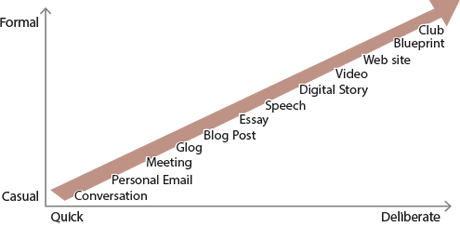68
Understanding the Communication Situation
Effective, clear communication requires that you first examine the situation. Every communication situation has five basic components.
The Communication Situation

- Sender: The creator of the message (speaker, writer, director, designer, marketer)
- Message: The subject and purpose (inform, persuade, entertain)
- Medium: The way the message is expressed (speech, email, ad, video, painting)
- Receiver: The audience of the message (listener, reader, viewer)
- Context: The place and time of the message (history, hurdles, opportunities)
Medium
Communication uses many media. This chapter focuses on the listener/speaker form, though later chapters will focus on written forms (reader/writer). Part 3 of this book includes other forms of communication, from videos to models to experiments to clubs. Media fall on a continuum from quick and casual to deliberate and formal.

Your Turn Think of one of your recent communication situations. Where would it fall on this graph?
